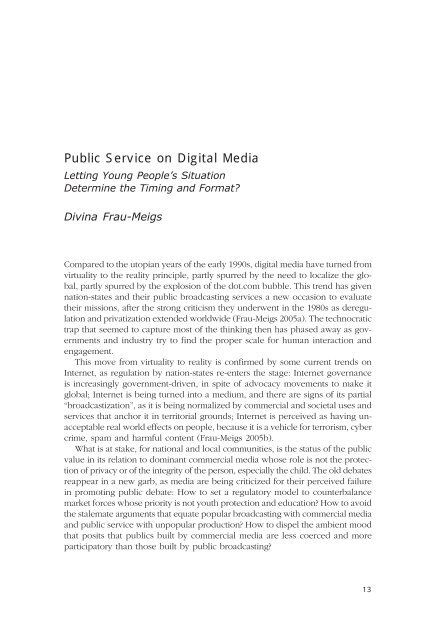In the Service of Young People? Studies and Reflections on Media ...
In the Service of Young People? Studies and Reflections on Media ...
In the Service of Young People? Studies and Reflections on Media ...
- No tags were found...
Create successful ePaper yourself
Turn your PDF publications into a flip-book with our unique Google optimized e-Paper software.
Public <str<strong>on</strong>g>Service</str<strong>on</strong>g> <strong>on</strong> Digital <strong>Media</strong>Letting <str<strong>on</strong>g>Young</str<strong>on</strong>g> <str<strong>on</strong>g>People</str<strong>on</strong>g>’s Situati<strong>on</strong>Determine <str<strong>on</strong>g>the</str<strong>on</strong>g> Timing <str<strong>on</strong>g>and</str<strong>on</strong>g> Format?Divina Frau-MeigsCompared to <str<strong>on</strong>g>the</str<strong>on</strong>g> utopian years <str<strong>on</strong>g>of</str<strong>on</strong>g> <str<strong>on</strong>g>the</str<strong>on</strong>g> early 1990s, digital media have turned fromvirtuality to <str<strong>on</strong>g>the</str<strong>on</strong>g> reality principle, partly spurred by <str<strong>on</strong>g>the</str<strong>on</strong>g> need to localize <str<strong>on</strong>g>the</str<strong>on</strong>g> global,partly spurred by <str<strong>on</strong>g>the</str<strong>on</strong>g> explosi<strong>on</strong> <str<strong>on</strong>g>of</str<strong>on</strong>g> <str<strong>on</strong>g>the</str<strong>on</strong>g> dot.com bubble. This trend has givennati<strong>on</strong>-states <str<strong>on</strong>g>and</str<strong>on</strong>g> <str<strong>on</strong>g>the</str<strong>on</strong>g>ir public broadcasting services a new occasi<strong>on</strong> to evaluate<str<strong>on</strong>g>the</str<strong>on</strong>g>ir missi<strong>on</strong>s, after <str<strong>on</strong>g>the</str<strong>on</strong>g> str<strong>on</strong>g criticism <str<strong>on</strong>g>the</str<strong>on</strong>g>y underwent in <str<strong>on</strong>g>the</str<strong>on</strong>g> 1980s as deregulati<strong>on</strong><str<strong>on</strong>g>and</str<strong>on</strong>g> privatizati<strong>on</strong> extended worldwide (Frau-Meigs 2005a). The technocratictrap that seemed to capture most <str<strong>on</strong>g>of</str<strong>on</strong>g> <str<strong>on</strong>g>the</str<strong>on</strong>g> thinking <str<strong>on</strong>g>the</str<strong>on</strong>g>n has phased away as governments<str<strong>on</strong>g>and</str<strong>on</strong>g> industry try to find <str<strong>on</strong>g>the</str<strong>on</strong>g> proper scale for human interacti<strong>on</strong> <str<strong>on</strong>g>and</str<strong>on</strong>g>engagement.This move from virtuality to reality is c<strong>on</strong>firmed by some current trends <strong>on</strong><str<strong>on</strong>g>In</str<strong>on</strong>g>ternet, as regulati<strong>on</strong> by nati<strong>on</strong>-states re-enters <str<strong>on</strong>g>the</str<strong>on</strong>g> stage: <str<strong>on</strong>g>In</str<strong>on</strong>g>ternet governanceis increasingly government-driven, in spite <str<strong>on</strong>g>of</str<strong>on</strong>g> advocacy movements to make itglobal; <str<strong>on</strong>g>In</str<strong>on</strong>g>ternet is being turned into a medium, <str<strong>on</strong>g>and</str<strong>on</strong>g> <str<strong>on</strong>g>the</str<strong>on</strong>g>re are signs <str<strong>on</strong>g>of</str<strong>on</strong>g> its partial“broadcastizati<strong>on</strong>”, as it is being normalized by commercial <str<strong>on</strong>g>and</str<strong>on</strong>g> societal uses <str<strong>on</strong>g>and</str<strong>on</strong>g>services that anchor it in territorial grounds; <str<strong>on</strong>g>In</str<strong>on</strong>g>ternet is perceived as having unacceptablereal world effects <strong>on</strong> people, because it is a vehicle for terrorism, cybercrime, spam <str<strong>on</strong>g>and</str<strong>on</strong>g> harmful c<strong>on</strong>tent (Frau-Meigs 2005b).What is at stake, for nati<strong>on</strong>al <str<strong>on</strong>g>and</str<strong>on</strong>g> local communities, is <str<strong>on</strong>g>the</str<strong>on</strong>g> status <str<strong>on</strong>g>of</str<strong>on</strong>g> <str<strong>on</strong>g>the</str<strong>on</strong>g> publicvalue in its relati<strong>on</strong> to dominant commercial media whose role is not <str<strong>on</strong>g>the</str<strong>on</strong>g> protecti<strong>on</strong><str<strong>on</strong>g>of</str<strong>on</strong>g> privacy or <str<strong>on</strong>g>of</str<strong>on</strong>g> <str<strong>on</strong>g>the</str<strong>on</strong>g> integrity <str<strong>on</strong>g>of</str<strong>on</strong>g> <str<strong>on</strong>g>the</str<strong>on</strong>g> pers<strong>on</strong>, especially <str<strong>on</strong>g>the</str<strong>on</strong>g> child. The old debatesreappear in a new garb, as media are being criticized for <str<strong>on</strong>g>the</str<strong>on</strong>g>ir perceived failurein promoting public debate: How to set a regulatory model to counterbalancemarket forces whose priority is not youth protecti<strong>on</strong> <str<strong>on</strong>g>and</str<strong>on</strong>g> educati<strong>on</strong>? How to avoid<str<strong>on</strong>g>the</str<strong>on</strong>g> stalemate arguments that equate popular broadcasting with commercial media<str<strong>on</strong>g>and</str<strong>on</strong>g> public service with unpopular producti<strong>on</strong>? How to dispel <str<strong>on</strong>g>the</str<strong>on</strong>g> ambient moodthat posits that publics built by commercial media are less coerced <str<strong>on</strong>g>and</str<strong>on</strong>g> moreparticipatory than those built by public broadcasting?13
















